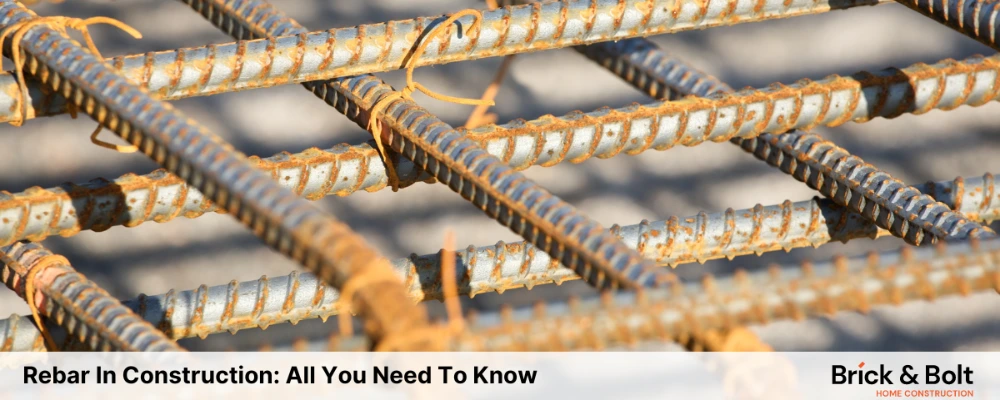Rebar or reinforcing bar acts as a strong backbone of modern construction projects. It typically adds strength and durability to concrete structures in the long run. They are made of steel and come in various types, sizes, and grades to support a variety of structures. Though fiberglass is a popular choice, rebar is non-magnetic and will not rust easily.
Still, many people are unaware of this technique and are facing troubles in concrete applications. In this blog, we’ll discuss in detail: what rebar is, its types, applications, and the significance of applying it in construction. Let’s delve into reading to learn more.
What is Rebar in Construction?
We all commonly know that concrete is brittle in nature and has less tensile strength, making it susceptible to cracks when force is applied. However, embedding rebar within the concrete enhances the tensile strength and significantly prevents cracks. It also ensures the strength and overall stability of the structure.
They come in many shapes and sizes, including square, round, and deformed bars. It can be used according to the project needs and specific applications.
Role of Rebar in Construction
Rebar, known as steel reinforcing bars made from carbon steel. During construction, these steel bars are placed within the freshly poured concrete. Together, they provide impressive support and strength to the building when it is subjected to stretching or pulling forces. When embedded, a composite material is created to withstand heavy loads.
Control Cracks & Structural Failures
The natural hardening or drying process in various weather conditions causes concrete to shrink and crack. This situation can be efficiently handled by improving structural integrity with rebar. It adds extra protection to the building and enhances the robustness and overall structural integrity against cracks. It is particularly suitable for constructions that needs to withstand heavy loads.
Distribute the Loads Efficiently
Buildings are subjected to various loads, which is why concrete construction is encouraged. All such loads and conditions are evenly distributed using rebar, so you can ensure the safety and stability of a building. The selection of rebar type should be based on construction needs and the project budget.
Sustainability of Constructions
Prioritising the sustainability of construction is significant. Concrete reinforced with rebar reduces the frequent maintenance and reconstruction work. It involves improving the longevity of the structures against all environmental impacts that tend to chemical exposure and cracks.
Cost-Effective Solutions
All the properties of steel bars positively influence the construction. Rebar is a practical solution to prevent structures from various repairs or problems caused by temperature fluctuations. This method prevents unwanted expenses and the overall possibility of costly occurrences.
Applications of Rebar in Construction
Rebar is used in numerous construction applications and is listed as follows:
Foundations: Rebar is an unavoidable choice for foundations as it provides integral stability and resistance to the building. It prevents settlement and can be used in piles, footings, and foundation slabs.
Beams and Slabs: Concrete slabs and beams highly require rebar to resist heavy loads and efforts, such as structure weight and variable loads (people, furniture, home accessories, etc.). It ensures durability and resists cracking.
Columns and Pillars: The rebar provides the biggest support to these vertical load-bearing elements and prevents the structure from buckling or deformation.
Walls: Incorporating rebar into the walls helps improve its resistance and stability. This is significant to seismic areas or a region with a risk of ground movements.
Rebar Grades
Understanding the purpose of tensile strength and yield strength in construction helps you select the appropriate grade of rebar you need for your construction. Each grade has unique properties, and based on the project needs, we need to choose the wise option.
In general, the yield strength in a building represents the minimum stress a material takes before deforming completely. Conversely, tensile strength denotes the maximum stress that a material can cause before being damaged or broken completely.
Commonly used rebar grades are 40, 60, 75, 80, and 100, the minimum grade rebar is primarily used to balance, with each grade having unique properties. The selection of rebar grade is based on the application-specific properties.
For instance: the minimum grade rebar is primarily used for balancing the strength and ductility. The maximum grade is ideal for earning the highest strength, especially for high-rise buildings, bridges, and dams.
In a Word
Rebar is a significant material for reinforced concrete that typically improves its strength and durability. Choosing the proper size, shape, and grade is crucial for project success. Before stepping forward, it is crucial to understand each grade’s properties, benefits, and cost differences to help find a reliable option. Having this in mind, you can consult with experts to avoid all possible challenges in the long run.
FAQs
Rebar, also known as reinforcing bar, ultimately provides sufficient strength to a structure and prevents cracking and shrinking. It helps ensure the durability and structural integrity of bridges, buildings, and high-rise buildings.
The rebar is typically placed within the concrete once it is poured. For proper positioning, it is embedded using wire ties or other methods. When both are set together, it provides essential strength and durability to the buildings.
Incorporating a rebar in concrete helps construction to withstand heavy loads. Additionally, they provide wear and tear resistance and prevent cracking.
A damaged section of rebar can be removed and replaced with new material, though this typically requires the assistance of experts with specialized equipment.
Rebar grade is crucial to consider when choosing for your construction project. Ensuring certain significant factors like ductility, strength, and corrosion resistance helps find the appropriate grade.

